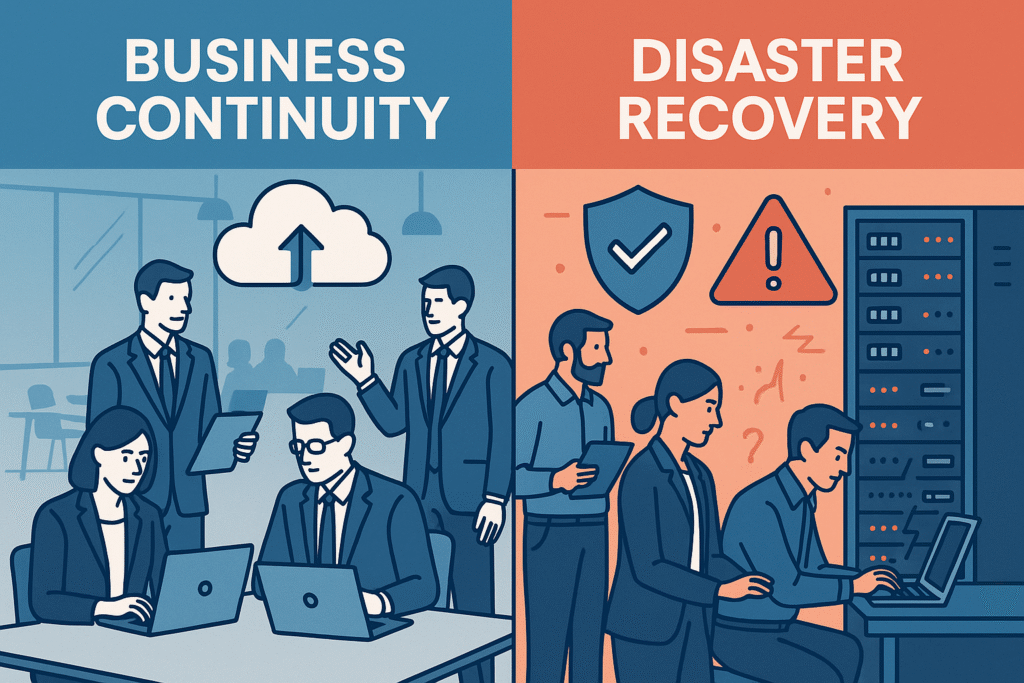In today’s volatile business environment, organizations face an unprecedented array of threats that can disrupt operations within minutes. From cyberattacks targeting critical infrastructure to natural disasters shutting down entire regions, the question isn’t whether disruption will occur; it’s when. Business continuity vs disaster recovery represents two fundamental yet distinct approaches to organizational resilience, each serving unique purposes in safeguarding your company’s future.
What Is Business Continuity?
Business continuity planning encompasses the comprehensive strategies and procedures that enable organizations to maintain essential operations during and immediately following disruptive events. This proactive approach extends far beyond technology recovery, addressing the human element, operational workflows, and alternative resource allocation that keep businesses functioning when normal operations become impossible.
The scope of business continuity definition includes establishing alternate work locations, implementing manual backup processes, maintaining supplier relationships during supply chain disruptions, and ensuring effective communication channels remain operational. Business continuity planning steps involve identifying critical business functions, developing workaround procedures, and creating protocols that allow organizations to serve customers and generate revenue even under adverse conditions.
Unlike reactive measures, business continuity operates on the principle of preparedness, ensuring that when disruption strikes, your organization can pivot seamlessly to predetermined alternative operations without losing momentum or market position.

What Is Disaster Recovery?
Disaster recovery represents the technical backbone of organizational resilience, focusing specifically on the restoration of IT systems, data infrastructure, and technological capabilities following catastrophic events. This specialized discipline concentrates on bringing digital assets back online, recovering lost data, and reestablishing the technological foundation upon which modern businesses depend.
The IT disaster recovery process involves systematic procedures for backing up critical data, implementing failover systems, and executing restoration protocols that minimize data loss and system downtime. A comprehensive disaster recovery plan encompasses everything from server restoration and network reconfiguration to database recovery and application functionality testing.
While business continuity keeps the lights on, disaster recovery ensures that the technological infrastructure powering those lights can be fully restored to pre-incident functionality, complete with all data integrity and system performance capabilities intact.
Business Continuity vs Disaster Recovery: Core Differences
Understanding the fundamental distinctions between these two critical disciplines requires examining their scope, timing, and primary objectives:
| Aspect | Business Continuity | Disaster Recovery |
|---|---|---|
| Primary Focus | Maintaining essential operations during disruption | Restoring IT systems and data infrastructure |
| Operational Scope | Data backups, system restoration,and failover procedures | Technology-focused data and system recovery |
| Implementation Timing | Organization-wide, including people, processes, and facilities | Primarily after the disruption, to restore normalcy |
| Core Activities | During and immediately after the disruption occurs | Primarily, after the disruption, to restore normalcy |
| Ultimate Goal | Minimize operational downtime and maintain business functionality | Return technological capabilities to pre-incident status |
| Resource Allocation | Data backups, system restoration, and failover procedures | Human resources, alternative locations, and manual workflows |
This comparison reveals that while both approaches address organizational resilience, they operate in different domains and timeframes, making them complementary rather than competing strategies.
Why Both Plans Are Essential for Resilience
Modern organizations cannot afford to treat business continuity and disaster recovery as mutually exclusive options. The importance of business continuity and disaster recovery lies in their synergistic relationship, where each approach addresses different aspects of comprehensive risk management.
Organizational resilience emerges when business continuity ensures operational continuity while disaster recovery guarantees technological restoration. During a crisis, business continuity enables immediate response and alternative operations, while disaster recovery provides the roadmap for returning to full technological capability.
Organizations lacking robust planning in either area face catastrophic risks, including revenue loss, customer defection, regulatory penalties, and permanent market share erosion. Professional business continuity services provide the expertise necessary to develop integrated approaches that address both operational and technological resilience requirements.
The financial implications extend beyond immediate incident costs. Companies without comprehensive planning face extended recovery periods, increased operational expenses during manual operations, and potential legal liabilities from data loss or service interruptions.
Similarities and Overlap Between Business Continuity and Disaster Recovery
Despite their distinct focuses, business continuity and disaster recovery similarities reveal shared foundational principles that strengthen organizational preparedness:
• Proactive risk management approach that anticipates potential threats rather than reacting after incidents occur • Regular testing and validation requirements ensuring plans remain current and executable under real-world conditions • Comprehensive threat assessment addressing natural disasters, cyber incidents, infrastructure failures, and human-caused disruptions • Cross-functional coordination requiring collaboration between IT, operations, human resources, and executive leadership • Documentation and communication protocols that ensure all stakeholders understand their roles during crisis situations • Continuous improvement processes that incorporate lessons learned from tests, actual incidents, and evolving threat landscapes
These BCDR best practices demonstrate that successful implementation requires treating both disciplines as interconnected components of a unified resilience strategy rather than isolated planning exercises.
Key Steps to Building Effective Plans
Developing comprehensive organizational resilience requires systematic progression through interconnected planning phases:
- Risk Assessment and Business Impact Analysis Conduct thorough analysis identifying critical business functions, potential threat vectors, and quantifiable impact assessments. This foundation determines planning priorities and resource allocation requirements.
- Developing the Business Continuity Plan Create detailed procedures for maintaining operations including alternate facility identification, manual process documentation, and communication strategies that enable continued customer service during disruptions.
- Developing the Disaster Recovery Plan Focus on technical recovery strategies encompassing data backup protocols, system restoration procedures, and failover mechanisms that restore full technological capabilities efficiently.
- Integration and Coordination: Ensure both plans complement each other through coordinated testing, shared communication protocols, and unified command structures that prevent conflicting directives during actual incidents.
- Testing and Training Implement regular simulation exercises, testing both operational continuity and technical recovery capabilities, identifying gaps, and refining procedures based on realistic scenarios.
- Review and Continuous Improvement: Establish scheduled review cycles that incorporate new threats, technological changes, business growth, and lessons learned from testing or actual incidents.
Comprehensive business continuity recovery solutions integrate these steps into cohesive programs that address both immediate operational needs and long-term resilience requirements.
Building a comprehensive plan can feel overwhelming. Simplify the process with our step-by-step guides, checklists, and templates. [Get Your Free BCDR Planning Toolkit]
Common Threats That Require Both Plans
Contemporary organizations face diverse threat landscapes that simultaneously impact operational and technological capabilities:
• Natural disasters, including floods, earthquakes, hurricanes, and wildfire,s that damage facilities while destroying IT infrastructure
• Cyberattacks and ransomware that compromise data integrity while disrupting normal business operations through system unavailability
• Power outages and utility failures that prevent normal operations while potentially corrupting data and damaging equipment
• Pandemic and health emergencies that restrict workforce availability while increasing dependence on remote technological capabilities
• Supply chain disruptions that interrupt operational inputs while requiring alternative procurement and communication systems
• Infrastructure failures, including telecommunications outages, transportation disruptions, and facility damage that impact both human and technological resources
The interconnected nature of these threats demonstrates why business continuity for cyberattacks and disaster recovery for natural disasters must work in tandem to provide comprehensive protection.
Real-World Consequences of Poor Planning
The financial and operational impact of inadequate preparedness extends far beyond immediate incident costs:
Business continuity statistics reveal sobering realities about organizational vulnerability. Twenty-five percent of businesses permanently close following major disasters, while the cost of downtime averages nearly $125,000 per hour during unplanned outages. Small businesses face even greater risks, with up to half never reopening after significant disasters.
These figures represent more than financial losses—they reflect destroyed livelihoods, eliminated jobs, and community economic damage that ripples through local markets. Organizations with comprehensive planning demonstrate significantly higher survival rates and faster recovery times, often gaining competitive advantages while unprepared competitors struggle with extended disruptions.
Insurance coverage rarely compensates for lost market share, damaged customer relationships, or regulatory penalties resulting from extended service interruptions. The reputational damage from prolonged outages often exceeds immediate financial losses, creating long-term challenges that affect business growth and market position.
Unplanned downtime can cripple your business. Don’t wait for a disaster to strike—get a head start on resilience.
How to Get Started: Take the Next Step Toward Resilience
Beginning comprehensive resilience planning requires an honest assessment of current capabilities and systematic gap identification. Organizations should start by cataloging critical business functions, identifying potential threats specific to their industry and location, and evaluating existing preparedness measures.
Professional guidance significantly accelerates planning effectiveness while ensuring compliance with industry standards and regulatory requirements. Expert consultation provides an objective assessment of vulnerabilities and customized solutions that address unique organizational needs.
The complexity of modern business operations demands specialized expertise in both operational continuity and technical recovery. Professional resilience solutions offer proven methodologies, industry best practices, and ongoing support that transform planning from an overwhelming challenge into a manageable process.
Frequently Asked Questions About Business Continuity and Disaster Recovery
What is the difference between business continuity and disaster recovery? Business continuity focuses on maintaining essential operations during disruptions, while disaster recovery concentrates on restoring IT systems and data after incidents. Business continuity is organization-wide and operational, while disaster recovery is technology-focused and restoration-oriented.
What’s the difference between DRP and BCP? A Disaster Recovery Plan (DRP) addresses technical system restoration, data recovery, and IT infrastructure rebuilding. A Business Continuity Plan (BCP) covers maintaining business operations, alternative processes, and organizational functionality during disruptions.
Is a disaster recovery plan a part of the business continuity plan? Disaster recovery planning complements business continuity planning but operates as a distinct discipline. While they should be coordinated, disaster recovery focuses specifically on technical restoration, while business continuity addresses broader operational continuity.
What is the difference between a disaster management plan and a business continuity plan? Disaster management plans address immediate emergency response and safety protocols during incidents. Business continuity plans focus on maintaining operational capability and ensuring business functions continue despite disruptions.
Ready to protect your business from the unexpected? Professional resilience planning ensures your organization can weather any storm while maintaining a competitive advantage in an unpredictable world.
